Flushing your car's coolant sytem is considered a routine maintenance procedure on any vehicle. By flushing your own coolant system, you can save yourself a considerable amount of money, and will only take a few minutes of your time. So, This how to article will cover the proper method of flushing and filling your engine's coolant system. Be sure to check your ownership manual for both the proper mixture ratio and coolant for your car. The ethylene glycol in antifreeze has a sweet odour and will attract animals which try to ingest it - it is highly toxic to them. Please do not simply drain your vehicle's antifreeze onto your work surface at all. You should be sure to collect any antifreeze that you drain and dispose of it properly as you would do with engine oil. For proper disposal method, please contact your municipality for details. In most cases, it is acceptable to dump the waste antifreeze down your toilet, flushing often as most water treatment facilities are more than capable of treating the water. This method does not apply to people who rely on septic tanks. Read on to learn how to flush your cars coolant system.
While it is certainly not required, placing the vehicle on ramps may aid in the flush + fill process. If you are inclined to raise the vehicle for ease of access, be sure to keep the vehicle level. First, ensure that the engine is allowed to cool to the point where the antifreeze will not burn you when you drain it from your coolant system. Once the engine has cooled, locate the radiator drain plug and place a large catch pan underneath it. The drain plug is always located at the bottom of the radiator. If you are so inclined, you do not need to allow the engine to cool however, be warned that the cooling system will likely be pressurized at this point! And the coolant will be extremely hot. | 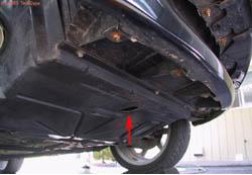 |
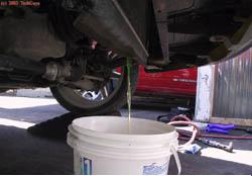 | It is recommended to use vinyl gloves because the ethylene glycol in antifreeze can cause skin damage - however we recommend this because the antifreeze feels like engine oil. With your catch pan in place, remove the radiator drain plug and collect all old coolant. Immediately dispose of the coolant as required by environmental laws - if you are to surrender the old coolant at a waste management facility, be sure you use containers which can be properly sealed to avoid spillage, etc. |
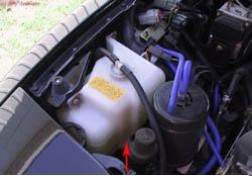 | To expedite the draining process, remove your radiator fill cap to allow air to enter the system. Also be sure to remove all coolant from your radiator reservoir. We suggest you use the gravity siphon trick - just be sure not to ingest any coolant. |
Watch the old coolant as it exits the system - this will give you a good idea of your vehicle's cooling system condition. If you see metal flakes, oily surface, white flakes, etc .. you can make a diagnosis of your engine's coolant system. Essentially, if you see anything but coolant and some very minor debris, it can indicate the early signs of cooling system failure. |  |
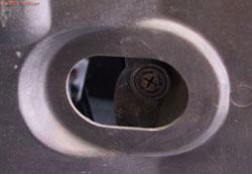 | When all coolant has been drained from the radiator, replace the radiator drain plug and then fill the system with plain tap water to dilute remaining antifreeze in the engine block. With the cooling system refilled with tap water, replace the radiator fill cap and run the engine allowing it to reach operating temperature. |
When the engine's cooling fan turns on, it is an indication that the vehicle's thermostat has opened, allowing the freshly added water to circulate through the engine thus diluting the remaining coolant. Allow the engine to run for a few minutes before shutting it off. At this point, you can either wait until the engine cools off, or take fate in your own hands and continue the flushing process. | 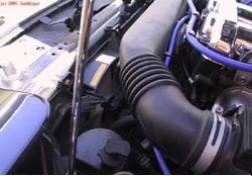 |
 | Repeat the draining process being sure to once again collect and dispose of all waste coolant. At this point, if you have opted to purchase a radiator flush kit, you should refill the cooling system with tap water and add the caustic fluid as directed. Run the engine for as long as the radiator flush kit calls for (usually less than 10 minutes). |
Once again, drain the cooling system, collecting all waste fluid. This is the last time you will be required to collect engine coolant during this process.
Now that the cooling system is empty, replace the radiator drain plug and refill the cooling system with distilled water only. The reason that you should only use distilled water at this point is to avoid mineral deposits which will deteriorate your cooling system over time. Once the cooling system has been completely filled, start the engine to allow the water to circulate. Once again remove the radiator drain plug. As the engine runs, pour fresh distilled water into the radiator fill hole at the same rate that it exits the system.
Continue this process until the water being drained from the radiator appears to be clear and free of debris. Once you are satisfied with the drain water's appearance, stop the engine and allow all remaining water to drain out. Replace the radiator drain plug and prepare to mix your distilled water and coolant.
Be sure to mix your coolant to the ratio recommended by your manufacturer. In most cases, the ratio is 50% distilled water and 50% coolant.
As a tip, mix the coolant and water in a third container being sure to observe the proper ratio. As you mix your water and coolant, use your hydrometer to measure the specific gravity - this will give you a good idea of whether or not you are mixing the coolant and water properly.
Once you have mixed enough coolant and water to fill your engine's coolant system entirely, grab a funnel and place it in the radiator fill hole.
Fill your radiator at a rate of no more than:
{ 1 L/min. \ 1.1 US qt./min. \ 0.9 Imp. qt./min. }.
Continue the filling process until the coolant reaches the bottom of the fill neck. Now fill the radiator reservoir to the full mark.
With the radiator fill cap still off, start the car and allow it to idle. As the engine runs, continue to add coolant as air escapes the engine and cooling system. As you top up the radiator, be sure to "burp" the cooling system by firmly squeezing the radiator hoses (both upper and lower). Continue to squeeze and release the hoses to help push any errant air bubbles out of the system.
Once you are unable to fill the radiator any further, replace the radiator fill cap and stop the engine - you are finished. Following your first drive after flushing and filling the cooling system, allow the engine to cool and check both the radiator and the radiator reservoir to ensure that both are at their full marks. Add coolant as required if either are low.
If you need any further assistance, feel free to post on our forums